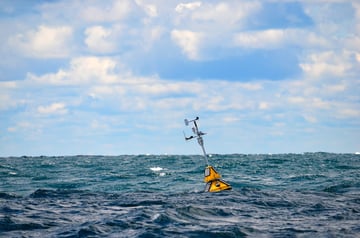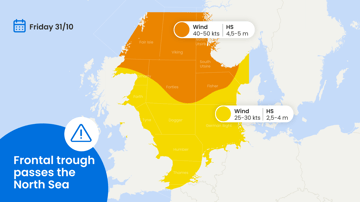Welcome to the Weekly Weather Update – your guided tour across the world’s oceans and seas. Each week, we analyse unusual and significant marine weather events: from tropical cyclones forming in equatorial waters, to shifting jet streams influencing oceanic storm tracks, to anomalies in sea-surface temperature that shape global climate patterns.
By combining observational data with meteorological insight, we’ll uncover how atmospheric dynamics interact with the oceans to drive the planet’s most fascinating – and sometimes extreme – weather phenomena.
North Sea
Autumn now seems to have firmly set in over the North Sea. In the coming week, several low-pressure systems will move across the northern part of the basin. The associated frontal systems will affect almost the entire North Sea. As these fronts pass, winds often strengthen to force 7–9 Beaufort, with gusts reaching up to around 40 knots.
On Thursday, a new low-pressure system will track across northern Scotland towards the Lofoten Islands, bringing another spell of unsettled weather there. At the same time, high pressure is building over the southern North Sea, resulting in much calmer conditions in that area (see Figure 1).
Hs will peak up to 3-4 meters over the middle and northern parts of the North Sea during the start of this week. In the southern part, Hs is mostly around 2,5-3 meters but will go down significantly on Friday.
Atlantic
A tropical disturbance is in the Atlantic Ocean, well W of the Cabo Verde islands. The system is currently producing a lot of unorganised showers and thunderstorms. Conditions for development are rather low until Wednesday morning, due to the presence of a dry and relatively stable airmass. That changes when the system is tracking further NW later this week. The system has a high likelihood to develop into a tropical depression and possibly tropical storm later this week (see Figure 2).
.png?width=644&height=473&name=image%20(9).png)
Figure 2: Development of a tropical system over the Atlantic. Source: NOAA
Indian Ocean
In the Indian Ocean, particularly just south of Australia and around Tasmania, very active weather is expected in the coming week. Numerous low-pressure systems will track from west to east, often passing just south of Tasmania. The central pressure of these systems frequently drops below 970 hPa, creating a steep pressure gradient and, as a result, very strong winds. Along Tasmania’s southern coast, sustained wind speeds of 25–30 knots are common. Especially during the passage of secondary lows on Friday and Saturday, sustained winds may briefly reach 40–50 knots, with gusts at times up to 75 knots.
Significant wave height (Hs) around Tasmania’s southern coast rarely drops below 4 meters. During the passage of fronts or secondary lows, Hs rises sharply to values between 6 and 6.5 meters.
Conclusion
In this article, we provided a rough overview of notable weather phenomena around the world. If you are interested in an offshore forecast tailored specifically to your location, please contact us!
Stay updated on LinkedIn
We plan to post this Weekly Weather Update on our Infoplaza for Marine Weather Operations LinkedIn page as well. This is also the place where we will share other insightful marine weather articles, so be sure to follow us to never miss an update.




